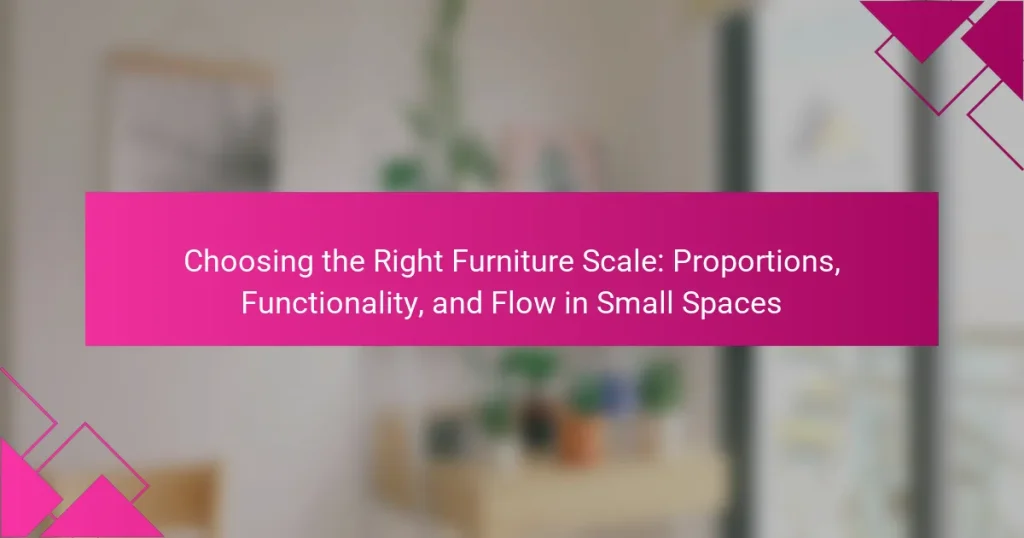Choosing the right furniture scale is essential for optimizing functionality and aesthetics in small spaces. Properly scaled furniture enhances the openness and accessibility of a room, while oversized pieces can create a cramped feeling. Conversely, furniture that is too small may compromise comfort and usability. This article explores the importance of furniture proportions, effective flow, and movement within limited areas, highlighting how well-scaled furniture can improve the perceived size of a room based on established interior design standards. Key concepts include the balance between proportion and functionality to maximize every square foot of space.

What is the Importance of Furniture Scale in Small Spaces?
Furniture scale is crucial in small spaces to optimize functionality and aesthetics. Properly scaled furniture ensures that the space feels open and accessible. Oversized furniture can overwhelm a small area, making it feel cramped. Conversely, furniture that is too small can lead to a lack of comfort and usability. The right scale promotes better flow and movement within the space. It allows for effective use of every square foot. Research indicates that well-scaled furniture can enhance the perceived size of a room. This principle is supported by interior design standards that emphasize proportion and balance in small environments.
How do Proportions Affect the Aesthetics of Small Spaces?
Proportions significantly influence the aesthetics of small spaces. Correct proportions create a sense of balance and harmony. When furniture is scaled appropriately, it enhances visual appeal. Oversized furniture can overwhelm a small room, making it feel cramped. Conversely, undersized furniture may lead to a disjointed appearance. The right proportions ensure that each element complements the others. This balance contributes to a more inviting atmosphere. Research shows that well-proportioned spaces promote comfort and usability. Therefore, understanding proportions is essential for aesthetic success in small spaces.
What are the Key Proportional Guidelines for Furniture in Limited Areas?
Key proportional guidelines for furniture in limited areas include selecting appropriately sized pieces that do not overwhelm the space. Furniture should be scaled to the dimensions of the room. For example, a small sofa or loveseat is preferable in compact living areas. Additionally, maintaining clear pathways is essential for functionality. Aim for at least 24 inches of walking space between furniture pieces. Multi-functional furniture can optimize limited areas. Items like ottomans with storage or fold-out tables increase utility without crowding. Finally, consider vertical space; tall bookshelves or wall-mounted shelves draw the eye upward, enhancing perceived space. These guidelines ensure comfort and usability in small environments.
How can Misproportioned Furniture Impact Space Perception?
Misproportioned furniture can significantly alter space perception. It can make a room feel cramped or overly spacious. Large furniture in a small room can dominate the space. This leads to a sense of confinement and discomfort. Conversely, small furniture in a large room can create a feeling of emptiness. This can make the space feel uninviting and disjointed.
Research indicates that proper proportions enhance visual harmony. According to a study by the Journal of Environmental Psychology, well-proportioned furniture promotes comfort and usability. Misproportioned pieces disrupt the balance of a room. This imbalance can negatively affect mood and functionality.
What Role Does Functionality Play in Choosing Furniture Scale?
Functionality is crucial in choosing furniture scale as it determines how well the furniture serves its intended purpose. The right scale ensures that furniture fits the space appropriately, allowing for ease of movement and usability. For example, a coffee table should be low enough for comfortable reach from a seated position. Additionally, multi-functional furniture, such as ottomans that provide storage, maximizes space efficiency. When furniture is appropriately scaled, it enhances the overall flow of a room, making it more inviting and practical. Studies show that well-scaled furniture contributes to improved user satisfaction in small spaces.
How Can Multi-Functional Furniture Optimize Small Spaces?
Multi-functional furniture optimizes small spaces by maximizing utility without sacrificing style. This type of furniture serves multiple purposes, such as a sofa bed that functions as both seating and a sleeping area. It reduces the need for excessive pieces, freeing up floor space. For example, a coffee table with storage can hold items while serving as a surface for drinks or snacks. According to a study by the American Institute of Architects, well-designed multi-functional furniture can increase usable space by up to 30%. This efficiency allows for better organization and a more open environment.
What Considerations Should Be Made for Accessibility and Movement?
Accessibility and movement in small spaces require careful planning. Ensure pathways are wide enough for wheelchair access, typically at least 36 inches. Furniture should be arranged to allow for easy navigation. Avoid placing obstacles in walking paths. Consider the height and reach of furniture for all users. Use lightweight furniture for easier rearrangement. Incorporate storage solutions that do not impede movement. Ensure that doors open fully without obstruction. These considerations enhance usability and safety in confined areas.
How Does Furniture Flow Contribute to Small Space Design?
Furniture flow significantly enhances small space design by promoting movement and accessibility. It ensures that pathways between furniture pieces are clear and functional. This arrangement prevents clutter and creates an open feel. Effective furniture flow allows for easy navigation, which is crucial in limited areas. Research shows that well-planned layouts can make spaces appear larger. According to a study by the American Society of Interior Designers, optimal furniture flow increases usability and comfort. Therefore, prioritizing furniture flow is essential in maximizing the functionality of small spaces.
What is the Concept of Flow in Interior Design?
The concept of flow in interior design refers to the seamless movement and connection between spaces. It emphasizes the arrangement of furniture and decor to create a harmonious environment. Effective flow allows for easy navigation throughout a space. This is particularly important in small areas where space is limited. Designers achieve flow by considering sightlines, color continuity, and spatial relationships. For example, an open layout promotes flow by minimizing barriers. Additionally, the choice of furniture scale can enhance flow by ensuring pieces fit proportionately within the space. Overall, flow contributes to both functionality and aesthetic appeal in interior design.
How Can Flow Be Achieved with the Right Furniture Choices?
Flow can be achieved with the right furniture choices by ensuring proper scale and arrangement. Selecting furniture that fits the dimensions of a space promotes movement and accessibility. For instance, a sofa that is too large can obstruct pathways, while appropriately sized pieces allow for easy navigation. Additionally, maintaining a cohesive style and color palette creates visual harmony. This consistency helps guide the eye through the space, enhancing the sense of flow. Furthermore, multifunctional furniture, such as ottomans that double as storage, maximizes utility without cluttering the area. Research shows that well-planned furniture layouts can improve spatial perception and user experience, supporting the notion that thoughtful choices significantly impact flow in small spaces.
What are the Common Mistakes to Avoid When Scaling Furniture?
Common mistakes to avoid when scaling furniture include neglecting room proportions, overlooking functionality, and failing to consider flow. Room proportions matter because furniture should complement the space. Oversized furniture can overwhelm a small room. Conversely, too-small furniture may look lost in a larger area. Functionality is crucial; furniture must serve its intended purpose effectively. For example, a sofa that is too low may be uncomfortable for users. Additionally, flow refers to how people move through a space. Poorly scaled furniture can obstruct pathways, making navigation difficult. Properly scaled furniture enhances aesthetic appeal and usability.
How Can Oversized Furniture Disrupt Small Space Harmony?
Oversized furniture can disrupt small space harmony by overwhelming the available area. It occupies more visual and physical space than intended. This can lead to a cramped and cluttered environment. Movement within the space may become restricted due to the large size of the furniture. Additionally, oversized pieces can obstruct natural light and airflow. This negatively impacts the overall ambiance and functionality of the area. Research indicates that proportionate furniture enhances spatial perception and comfort. Therefore, selecting appropriately scaled furniture is crucial for maintaining harmony in small spaces.
What are the Signs of Poor Furniture Scale in a Room?
Signs of poor furniture scale in a room include oversized furniture that overwhelms the space. This can make the room feel cramped and uninviting. Conversely, undersized furniture may lead to a lack of cohesion and functionality. The furniture may appear lost in the room, failing to create a balanced look. Additionally, pathways can feel obstructed with oversized pieces, disrupting flow. In contrast, too many small items can clutter the space and create visual chaos. Proper scale is essential for comfort and usability in a room. A well-proportioned room enhances aesthetic appeal and promotes ease of movement.
How Can I Effectively Measure and Choose the Right Furniture Scale?
To effectively measure and choose the right furniture scale, start by assessing the dimensions of your space. Measure the length, width, and height of the area where the furniture will be placed. Consider the proportions of existing elements like walls, windows, and doors.
Next, evaluate the size of the furniture. It should complement the space without overwhelming it. Use a tape measure to compare the furniture dimensions against your space measurements.
Check the scale in relation to other furniture pieces. Ensure there is a balance in size among all items in the room. For instance, large sofas should be paired with substantial coffee tables.
Consider functionality as well. The furniture should not only fit well but also serve its intended purpose effectively.
Lastly, visualize the arrangement. Use painter’s tape to outline the furniture dimensions on the floor. This will help in visualizing how the furniture will fit and flow within the space.
What Tools and Techniques Can Help in Measuring Space?
Laser distance measurers provide accurate measurements of space. They use laser technology to calculate distances quickly. Tape measures are traditional tools that offer manual measurement of lengths. They are versatile and easy to use for various dimensions. Digital measuring tools convert measurements into digital formats for convenience. These tools often include features like storing measurements and calculating areas. 3D scanning technology captures entire spaces in three dimensions. This technique is useful for creating detailed floor plans. Software applications for smartphones can assist in measuring spaces using augmented reality. These apps leverage the phone’s camera and sensors for quick measurements. Each of these tools and techniques enhances the process of measuring space effectively.
What Tips Should I Follow for Selecting Furniture That Fits My Space?
Measure your space accurately before selecting furniture. Use a tape measure to determine the dimensions of the room. Consider the layout and flow of movement in the space. Ensure there is enough room for doors and pathways. Choose furniture that complements the scale of the room. For example, large furniture can overwhelm a small space. Select multi-functional pieces to maximize usability. Items like ottomans with storage can save space. Stick to a cohesive color palette to create a unified look. This approach visually expands the area.
The main entity of this article is furniture scale, specifically in the context of small spaces. The article emphasizes the importance of selecting appropriately scaled furniture to enhance functionality, aesthetics, and flow within limited areas. It outlines key guidelines for achieving proper proportions, the impact of misproportioned furniture on space perception, and the role of multi-functional pieces in optimizing usability. Additionally, it discusses common mistakes to avoid, tools for measuring space, and tips for selecting furniture that fits well within a given area, ultimately promoting a harmonious and inviting environment.


